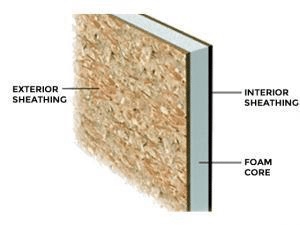INSULATED PANEL SYSTEMS
Structural insulated panels (SIPs)
Structural insulated panels (SIPs) are a high performance building system for residential, light commercial and industrial construction. The panels consist of an insulating foam core sandwiched between two structural facings, typically oriented strand board (OSB). SIPs are manufactured under factory controlled conditions and can be fabricated to fit nearly any building design. The result is a building system that is extremely strong, energy efficient and cost effective. Building with SIPs will save you time, money and labor.

Are Structural Insulated Panels More Expensive?
Building with SIPs generally costs about the same as building with wood frame construction when you factor in the labor savings resulting from shorter construction time and less jobsite waste. Other savings are realized because smaller heating and cooling systems are required with SIP construction.
SIPs do an impressive job of slowing down the transfer of heat, air, and vapor through the assembly. They also dramatically reduce the drying potential of the enclosure, lessening its ability to recover from inadvertent water intrusion. Such an airtight assembly with great thermal resistance can result in a high-performance and durable enclosure if detailed and built correctly.
DESCRIPTION
Structural insulated panels are composed of an insulated foam core between two rigid board sheathing materials. The foam core is generally one of the following: expanded polystyrene (EPS), extruded polystyrene (XPS), and polyurethane foam (PUR). With EPS and XPS foam, the assembly is pressure laminated together. With PUR and PIR, the liquid foam is injected and cured under high pressure.
The most common sheathing boards are oriented strand boards (OSB). Other sheathing materials include: sheet metal, plywood, fiber-cement siding, magnesium-oxide board, fiberglass mat gypsum sheathing, and composite structural siding panels.
Each sheathing material and foam type has its benefits and drawbacks. The type of SIPs selected depends upon the building type and site conditions. The following tables outline the benefits and drawbacks of the most common sheathing and foam types.
Table 1: Sheathing Type Chart
| SHEATHING TYPE | BENEFITS | DRAWBACKS |
|---|---|---|
| Oriented Strand Board (OSB) | Load bearing; readily available; tested; large panel size up to 8' x 24' | Subject to mold and a reduction in structural capacity if exposed to moisture; not fire resistant; must be treated for termites; difficult substrate for most common joint tapes |
| Sheet Metal | Reistant to mold; can be load-bearing; very light; unlimited lengths when made from coil stock | Must be galvanized or stainless steel; not load bearing |
| Plywood | Lateral strength | Availability; price; limited panel size; subject to mold and reduced structural capacity if exposed to moisture for a prolonged period of time; not fire resistant; must be treated for termites |
| Fiber Cement Siding | Resistant to mold, termites, and fire | Availability; weight; testing; limited panel size |
| Magnesium Board | Resistant to mold, termites, and fire | Availability; testing; limited panel size |
| Fiberglass Mat Gypsum Sheathing | Resistant to termites and fire | Not structural; limited panel size |
| Composite Structural Siding Panels | Resistant to mold and termites; pre-primed materials available | Not fire resistant |
Table 2: Core Type Chart
| FOAM CORE | BENEFITS | DRAWBACKS |
|---|---|---|
| Expanded Polystyrene (EPS) | Least expensive; thickness options are only limited by the foam manufacturer; availability; fastest to modify in field; most benign blowing agent | Produced with HBCD* |
| Extruded Polystyrene (XPS) | Strength; water resistant | Availability; produced with HBCD* |
| Polyurethane Foam (PUR) | Highest R-value/inch; strength, water resistant | Most expensive; harder to modify thickness limitations; creep; availability; produced with chlorinated phosphate flame retardants** |
*HBCD: hexabromocyclododecane - a brominated fire retardant classified by the European Union (REACH program) as persistant, bioaccumulative, and toxic (PBT).
**Not as hazardous as most brominated flame retardants, but health and environmental concerns still exist.
Source: BuildingGreen Insulation Report
Table 3: Foam Technical Data
| FOAM TYPE* | EPS FOAM | XPS FOAM | PUR FOAM |
|---|---|---|---|
| Density in Panel (lb/ft3) | 0.90 | 1.5 | 2.3 – 2.5 |
| Compressive Strength @ 10% deformation (psi) | 10 | 20 | 35 |
| R-value/in @ 75° F | 3.6 | 5.0 | 6.54 |
| Permeance per inch | 5 | 1.1 | 2.00 |
| Common Fire Retardant | HBCD | HBCD | TCPP |
| Common Fire Rating Class | 1 | 1 | 1 |
| Common Blowing Agent | Pentane | HFC—134a | HFC—245fa |
* Most SIP manufacturers use a 0.95 minimum density.